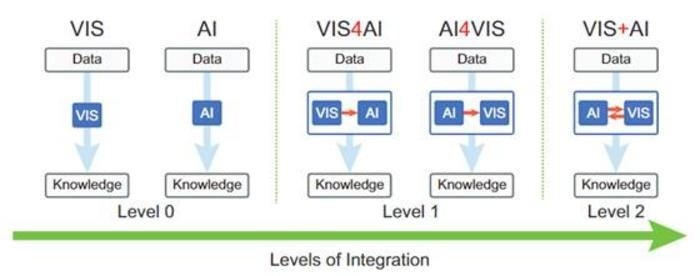Visualization and artificial intelligence (AI) are frequently used techniques in data analysis. Complex data analysis contexts, such as epidemic tracking and urban planning, necessitate the comprehension of vast data and the making of decisions, demanding the synergy of visualization and AI. However, the way in which AI and visualization can enhance each other and be incorporated into data analysis processes remains unclear.
 Image Credit: Shutterstock
Image Credit: Shutterstock
In response to these issues, Prof. Wei Chen led a research team to publish their fresh insights in the journal Frontiers of Computer Science, co-published by Higher Education Press and Springer Nature.
The team establishes three levels of integration between visualization and AI. Initially, visualization and AI are applied independently, forming data analysis methods at level 0: an independent process. As the technology progresses, visualization and AI have been employed to aid each other. These related methods are termed VIS4AI and AI4VIS, representing level 1: unilateral assistance. Unilateral assistance does not facilitate feedback. Level 1 strategies do not offer the opportunity to evaluate or enhance the impact of the provided aid. For the advancement of data analysis methods, the subsequent level calls for mutual assistance, known as level 2: profound integration.
VIS+AI strives for unobstructed communication between human cognition and artificial intelligence in visual analysis scenarios. The VIS+AI structure can fully unlock the passage between AI and visualization, fostering a stronger connection with human intellect. As portrayed on the structure's left side, the knowledge creation model is passed down from the prior level to incorporate human intelligence. As illustrated on the right side of the structure, the pathway between AI and visualization comprises three repetitive cycles: an interaction loop, an implementation loop, and an intelligence refinement loop. Through these three cycles, AI can adjust to fluid data analysis operations, thus becoming deeply embedded in the data analysis procedures steered by humans.
Practical implications
- The integration of visualization and AI can lead to more efficient data analysis in complex scenarios such as epidemic traceability and city planning.
- The proposed framework of VIS+AI can facilitate direct communication between human intelligence and AI through visual interfaces, allowing AI to learn from human interactions and improve its performance.
- The paper provides potential directions for future research on VIS+AI, which can inspire new studies and further improve the efficiency of data analysis in various domains.
Overall, the paper suggests that the integration of visualization and AI can greatly benefit data applications and improve decision-making processes.

Three levels of integration of VIS and AI in data analysis
Source:
Journal reference: